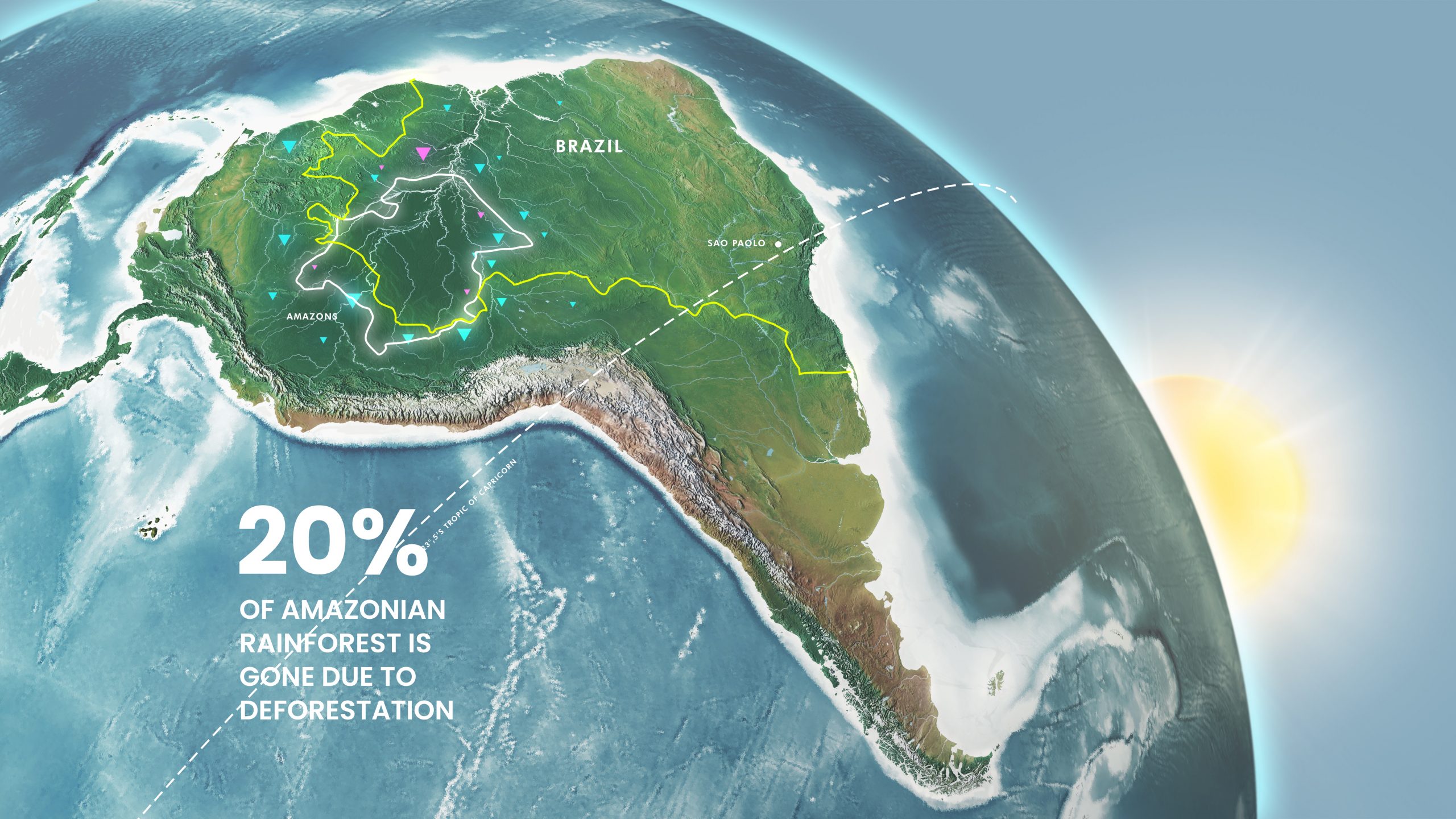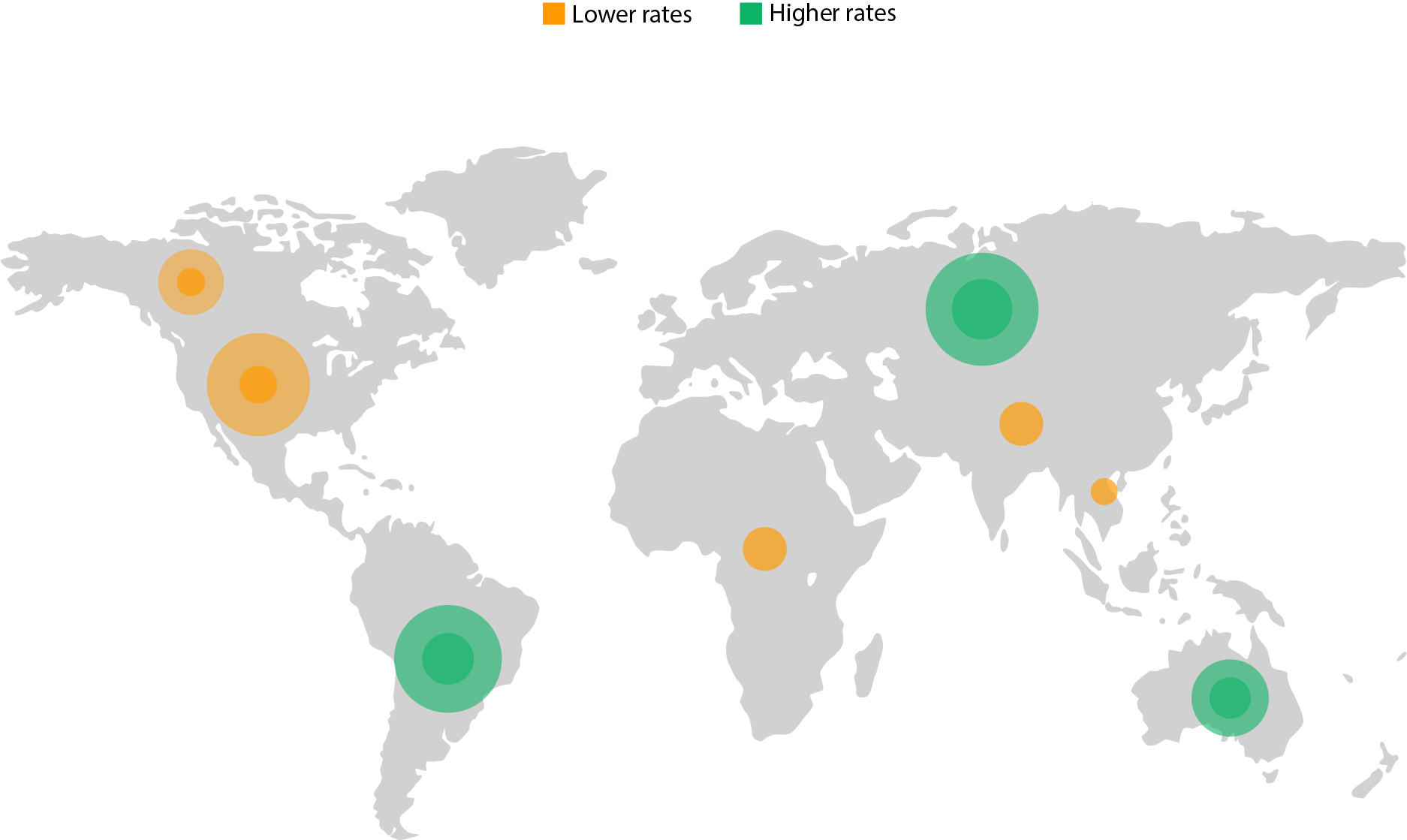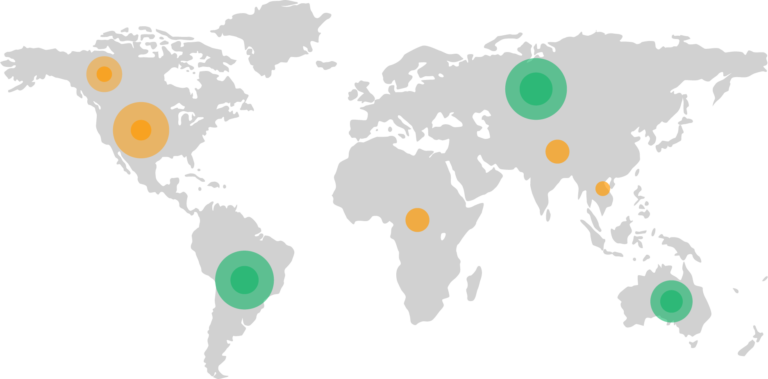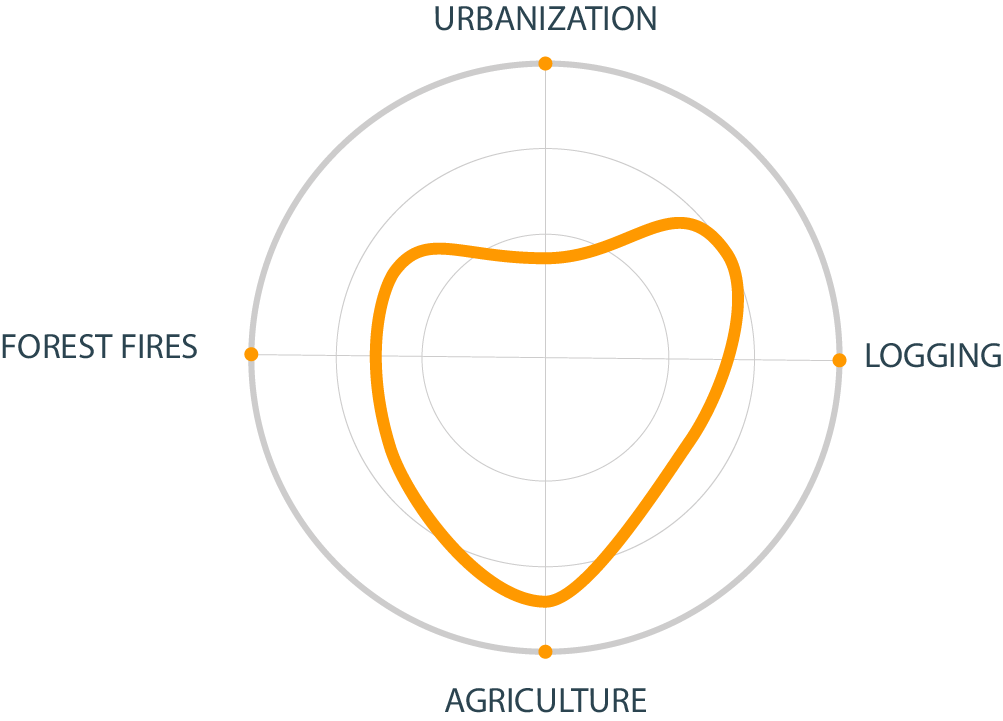THE STATE OF
FORESTS
AND FORESTRY
THE STATE OF
Forests
and Forestry
2023
Climate change and it’s escalation indicate that deforestation remains as one of the key factors contributing to what is regarded as one of the biggest ongoing crises humanity has been facing for decades now.
The scale of awareness and environmental action has increased in recent years, both of those being phenomena which have led to a slight decrease in deforestation. However there is still way more that can be done in this direction.
Lawnstarter has compiled a list of useful facts on the current state of deforestation, main contributing factors, its various effects on the environment and much more.
Key Takeaways
◉ Forests cover 31% of the world’s land area
◉ The world has lost 33% of its forest cover in the last 10,000 years
◉ About 15 billion trees are cut down by people annually
◉ About 50,000 of species are lost due to deforestation every year
◉ Around 1.6 billion people globally are impacted by deforestation
◉ Around 90% of deforestation worldwide is caused by agriculture
◉ Trends indicate that only 10% of rainforests will be left by 2030
How Much Deforestation Occurs Each Year?
Every year, an area of forest the size of the United Kingdom is destroyed throughout the world, the majority of it consisting of tropical rainforest, with disastrous consequences for the climate emergency and species.

The Amazonian rainforest, often referred to as “the lungs of the planet”, has lost around 17% of its forest area in the last 50 years due to deforestation.
Between the summer of 2020 and the summer of 2021 data shows that 13,235 square kilometers (5,110) of the Amazonian rainforest was destroyed.
If the current pace of deforestation continues in a rainforest as crucial as the Amazon, it’s estimated that by 2030 the rate of said forest loss will go up to 27%.
The Amazonian rainforest, often referred to as “the lungs of the planet”, has lost around 20% of its forest area due to deforestation.
Between the summer of 2020 and the summer of 2021 data shows that 13,235 square kilometers (5,110 sq.mi) of the Amazonian rainforest was destroyed.
If the current pace of deforestation continues in a rainforest as crucial as the Amazon, it’s estimated that by 2030 the rate of said forest loss will go up to 27%.
Countries With the Highest Deforestation Rates in the World
Deforestation is a huge problem in the world, damaging both our environment as well as jeopardizing a lot of species that call these forests home.
Large-scale forestry activities inside managed forests and tree plantations were the primary cause of tree cover loss.
Russia accounts for the largest share of tree cover loss followed by Brazil, which has seen an increase in deforestation in the Brazilian Amazon as well as an increase in the number of forest fires
The U.S is listed as one of the top 5 countries with the most deforestation (1.9 million hectares lost in 2020).

In many countries across the globe, trees are being cut down much faster than they’re naturally growing back.
hectares of tree cover was lost in Russia compared to 3.7 mha in 2019
hectares of tree cover destroyed in Brazil compared to 2.7 mha in 2019
hectares of tree cover lost in Australia compared to 1.6 mha in 2019
Countries With the Highest Deforestation Rates in the World
Deforestation is a huge problem in the world, damaging both our environment as well as jeopardizing a lot of species that call these forests home.
Large-scale forestry activities inside managed forests and tree plantations were the primary cause of tree cover loss.
Russia accounts for the largest share of tree cover loss followed by Brazil, which has seen an increase in deforestation in the Brazilian Amazon as well as an increase in the number of forest fires
The U.S is listed as one of the top 5 countries with the most deforestation (1.9 million hectares lost in 2020).

In many countries across the globe, trees are being cut down much faster than they’re naturally growing back.
hectares of tree cover was lost in Russia
hectares of tree cover destroyed in Brazil
hectares of tree cover lost in Australia
Deforestation in the U.S
U.S is listed as one of the top 5 countries with the most forest distribution, an estimation reveals that 7.6% of the world’s forests are in the US, in other words about 310 million hectares.
+
+
+
Wildfires and acres burned in the US from 1983-2021
SOURCE: National Interagency Fire Center
The number of fires across the U.S for the last five years paints a picture of the ever increasing deforestation and the cycle between the phenomenon and wildfires. In 2021 there were 58,985 fires affecting 7,100,000 acres, for 2020 58,950 fires affected 10,122,336 acres. In 2019 there were 50,477 fires recorded, affecting 4,664,364 acres and for 2018, 58,083 fires recorded, affecting 8,767,492 acres in total.
Predictions for the summer of 2022 point towards a hotter than average summer across the United States. July and August standing out as the hottest months in many regions.
Ways to Prevent Forest Fires
- Obey the Laws Regarding Open Fires
- Keep Anything Flammable Away
- Have Firefighting Tools in Hand
- Never Leave Fires Unattended
- Make Sure to Dispose Hot Charcoal
- Carefully Drown All Fires
- Extinguish Smoking Materials Carefully
As the data shows, wildfires have become an increasing issue for regions all over the United States, however there are some states more affected than others. California, Oregon, Montana, Washington and Arizona are the top five states with the most area burned by wildfires in 2021.
Comparatively the continent of Europe has a lower number of areas burned by wildfires in 2021.
Why Are
Our Forests Important?
Forests shelter many species and they continue to provide a living for humans as well. Not only that but they help with issues such as climate change, water conservation and much more.
15% of carbon emissions
are caused by deforestation,
forests contain about 210 gigatons of carbon preventing it from being released in the atmosphere and contributing to climate change.
20% of GHG emissions
worldwide are caused by deforestation. Cutting down trees helps release massive amounts of the carbon dioxide.
28% of earth’s oxygen
is produced by rainforests, one tree on average can produce 260 pounds of oxygen each year.
A family of four can survive on oxygen provided by two mature trees alone.
that we use today are derived from plants native to rainforests, it’s estimated that 70% of the anti-cancer plants that have been identified and are used today come from rainforests.
in cities can be cut down by tall trees with dense crowns and a soft ground surface or soil.
are filtered by a single tree during a full year.
Forests cover 31% of the entire world’s land area
Forests are an integral part of the entire land area for the planet. As an ecosystem they represent one of the most biodiverse in the world. Though they are crucial these forests are not spread out equally throughout the planet.
80% of the world’s amphibians, 77% of world’s birds and 68% of mammals live in forests
A large number of various species find their homes in the forest. The loss of forests increases the risk of extinction for many of these species therefore damaging the diversity of the ecosystems they contribute to.
Approximately 75% of the world’s accessible freshwater is derived from forests
About 180 million people in over 68.000 communities worldwide rely on forests as their primary resource of water. Even cities like Los Angeles and Atlanta receive a big portion of their water supply from forests.
1.6 Billion people worldwide depend on forests for their livelihoods
Deforestation impacts the lives of one third of the world’s population. Most of the people impacted depend on forests for water and other commodities. A majority of them live in poverty and as such are heavily reliant on these forests for their livelihoods.
Main Causes
of Deforestation
There’s multiple factors that contribute to deforestation globally varying from consumption of products that require raw materials generated from trees to unprecedented forest fires and more.
Some of the most prevalent causes leading to the current statistics remain agriculture, logging, forest fires and urbanization.
Agriculture
Logging
Logging operations are responsible for 30-40% of deforestation, even as much as 70% with intensive logging and careless felling methods.
Forest Fires
Urbanization

Where the Future is Headed?
Even though there’s been a decrease in the rate of deforestation since the 90s, the data shows that the pace of this progress has significantly slowed down in the last decade especially in Europe and Asia. As of right now this forest area worldwide continues to decrease by an average of 4.7 million hectares per year. If this trend continues the goal of increasing the forest area globally by 3% is unlikely to be achieved by 2030.
Restoring forests could be one of the first steps towards ensuring a better, more sustainable future. There’s about 51.6 million hectares of land that used to be forested that could be restored in the United States alone. This restored land could potentially capture 314 million tons of CO2 which would be the same as removing 67 million vehicles from the road every year. This could be a tremendous step in the right direction!
What Can You Do to Help?
Sometimes it may seem like there is not much that can be done on an individual level and that only major international intervention can lead to substantial change. But there is a part everyone can play in order to help halt deforestation little by little.
01
Plant more trees
start from your own community and help enrich your environment
02
Be a smart consumer
try to buy products that do not contain palm oil
03
Reduce, Reuse and Recycle
this way you’re not contributing to over-consumption
04
Support NonProfits
find organizations that you believe in that share similar values and make a donation to support their cause